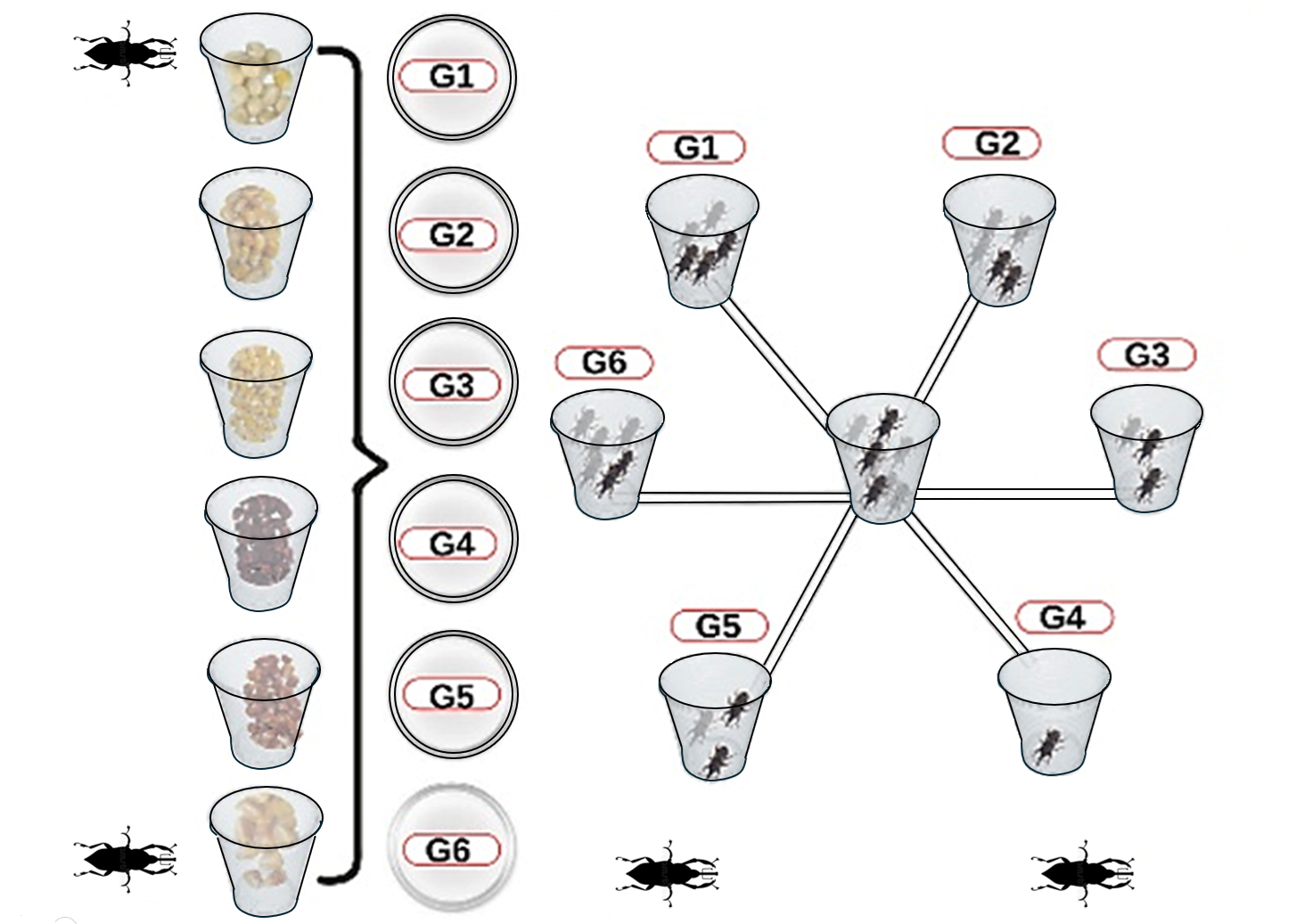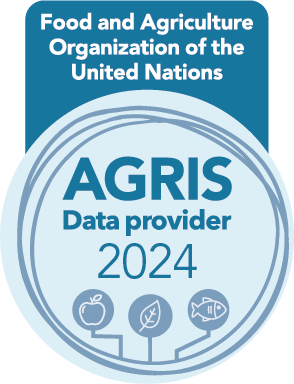Antixenosis of different maize genotypes in storage affects feeding preferences and oviposition of Sitophilus zeamais Moth
DOI:
https://doi.org/10.17268/sci.agropecu.2025.031Keywords:
antixenosis, maize, post-harvest, Sitophilus zeamaisAbstract
During corn storage, significant losses occur due to pest attacks, especially the weevil, Sitophilus zeamais Motschulsky. This study aimed to evaluate the feeding preference of Sitophilus zeamais on seeds of stored corn genotypes. The tests were carried out in the laboratory of the Center for Scientific and Technological Development in Pest and Disease Management (NUDEMAFI) at the Center for Agricultural Sciences and Engineering of the Federal University of Espírito Santo (UFES) in Alegre, in an air-conditioned room with a maximum temperature of 26.4 and a minimum of 26.2 ºC (± 2 ºC) and humidity between 70% and 75%. A host preference test with free choice was performed on insects from Nudemafi breeding, aged 5 to 10 days, in six (6) arenas with six (6) replicates using a completely randomized design (CRD). After 96 hours, the following were evaluated for each genotype: number of insects attracted, insect weight, number of infested seeds, percentage of seed loss, and 60 days after infestation, the percentage of emerged insects, physical and bromatological composition were determined. The results showed significant differences in the preference of Sitophilus zeamais adults in relation to the maize genotypes analyzed; the lowest food preference was observed in the Purple genotype (4.1%), followed by AG1051, which obtained 8.3% respectively. The genotypes presented antixenosis due to the effect of the nutritional properties and physical hardness of the seed.
References
Antunes, L. E., Viebrantz, P. C, Gottardi, R., & Dionello, R. G. (2011). Características físico-químicas de grãos de milho atacados por Sitophilus zeamais durante o armazenamento. Revista Brasileira de Engenharia Agrícola e Ambiental, 15, 615-620. https://doi.org/10.1590/S1415-43662011000600012
Alves, L. S., & Poltronieri, A. S. (2024). Resistência de três genótipos de milho ao ataque de Sitophilus zeamais Motschulsky, 1885 (Coleoptera: Curculionidae) em laboratório. Research, Society and Development, 13(5), e129135454864. https://doi.org/10.33448/rsd-v13i5.45864
Arnason, J. T., Baum, B., Gale, J., Lambert, J. D. H., Bergvinson, D., Philogene, B. J. R., & Jewell, D. C. (1993). Variation in resistance of Mexican landraces of maize to maize weevil Sitophilus zeamais, in relation to taxonomic and biochemical parameters. Euphytica, 74. https://doi.org/10.1007/BF00040405
Boiça JR, A. L., Lara, F. M., & Guidi, F. P (1997). Resistance of corn genotypes to attack by Sitophilus zeamais Mots. (Coleoptera: Curculionidae). Annals of the Entomological Society of Brazil, 26, 481-485. https://doi.org/10.1590/S0301-80591997000300010
Burgos-Díaz, J. A., Rangel-Fajardo, M. A., Tucuch-Haas, J. I., Benítez-Riquelme, I., & García-Zavala, J. J. (2020). Susceptibility of native maize populations and preference of the weevil in Yucatán, México. Revista mexicana de ciencias agrícolas, 11(7), 1469-1479. https://doi.org/10.29312/remexca.v11i7.2081
Brasil. (2009). Rules for seed analysis. Ministry of Agriculture, Livestock and Food Supply. Secretariat of Agricultural Defense. Brasília, DF: Mapa, 395p. https://www.gov.br/agricultura/pt-br/assuntos/insumos-agropecuarios/arquivos-publicacoes-insumos/2946_regras_analise__sementes.pdf
Conceição, E. D. R. S., de Souza David, A. M. S., Paraizo, E. A., Soares, L. M., Figueiredo, J. C., Alvarenga, C. D., ... & da Silva, J. P. M. (2024). Quality of corn seeds infested with Sitophilus zeamais after application of plant extracts and diatomaceous earth. Caderno Pedagógico, 21(13), e11587-e11587. https://doi.org/10.54033/cadpedv21n13-102
Compton, J. A., Floyd, S., Ofosu, A., & Agbo, B. (1998). The modified count and weigh method: An improved procedure for assessing weight loss in stored maize cobs. Journal of Stored Products Research, 34(4), 277-285. https://doi.org/10.1016/S0022-474X(98)00009-5
Cruz, I. Cruz, J. C., Karam, D., Monteiro, M. A. R., & Magalhaes, P. C. (2008). A cultura do milho. Sete Lagoas: Embrapa Milho e Sorgo, 2008. cap. 12, p. 303-362.
Fazolin, M., da Costa, C. R., Damaceno, J. E., de Albuquerque, E. S., Cavalcante, A. S. da S., Estrela, J. L. V. (2010). Fumigation of maize for weevil control using Tanaecium nocturnum (Bignoniaceae). Pesq. agropec. bras., 45(1). https://doi.org/10.1590/S0100-204X2010000100001
Frazão, C. A. V., Silva, P. R. R., Almeida; W. A. de., Pontual, E. V., Cruz, G. dos S., Napoleão, T. H., & França, S. M. de. (2018). Resistance of maize cultivars to Sitophilus zeamais (Coleoptera: Curculionidae). Arquivos do Instituto Biológico, 85, 1-8. https://doi.org/10.1590/1808-1657000552017
Fernandes, G. B. (2022). Dynamic conservation of maize landraces by family farmers in Minas Gerais, Brazil. Agrociencia Uruguay, 26(NSPE3), e959. https://doi.org/10.31285/agro.26.959
Gallo, D., Nakano, O. N., Silveira Neto, S., Carvalho, R. P. L. C., Batista, G. C. D., Berti Filho, E., Parra, J. R. P., & Zuchi, R. A. (2002). Entomologia agrícola. Piracicaba; FEALQ. p. 839-840.
García-Lara, S., Espinosa Carrillo, C., & Bergvinson, D.J. (2007). Manual de Plagas en Granos Almacenado y Tecnologías Alternas para su Manejo y Control; CIMMYT: El Batán, Mexico.
Guzzo, E. C., Alves, L. F. A., Zanin, A., & Vendramin, J. D. (2002). Identification of corn materials resistant to attack by the weevil Sitophilus zeamais (Mots., 1855) (Coleoptera: Curculionidae). Archives of the Biological Institute, 69(2), 69-73. https://doi.org/10.1590/1808-1657v69n2p0692002
Hogenhout, S. A., & Bos, J. I. (2011). Effector proteins that modulate plant–insect interactions. Current opinion in plant biology, 14(4), 422-428.https://doi.org/10.1016/j.pbi.2011.05.003
Kim, S. K., & Kossou, D. K. (2003). Genetic responses of resistant maize germplasm to the maize weevil Sitophilus zeamais Motschulsky in West Africa. J. Prod. Stored Res., 39, 489–505. https://doi.org/10.1016/S0022-474X(02)00056-5
Maggioni, K., Silva, L. B., Xavier, Z. F., de Bortoli Munhae, C., Dourado, L. R. B., & Pavan, B. E. (2016). Performance of populations of Sitophilus zeamais Motschulsky (Coleoptera: Curculionidae) on different varieties of maize. African Journal of Agricultural Research, 11(10), 873-881. https://doi.org/10.5897/AJAR2015.10505
Muzemu, S., Chitamba, J., & Goto, S. (2013). Screening of stored maize (Zea mays L.) varieties grain for tolerance against maize weevil, Sitophilus zeamais (Motsch.). International Journal of Plant Research, 3(3), 17-22. https://doi.org/10.5923/j.plant.20130303.01
Nwosu, L. C. (2016). Chemical bases for maize grain resistance to infestation and damage by the maize weevil, Sitophilus zeamais Motschulsky. Journal of Stored Products Research, 69, 41-50. https://doi.org/10.1016/j.jspr.2016.06.001
Pacheco, F. P. F. (2009). Storage proteins and preference of Sitophilus sp. for local and improved rice (Oryza sativa L.) varieties grown under different soil management conditions. Dissertação Mestrado em Agroecologia. Universidade Estadual do Maranhão.
Panizzi, A. R., & Parra, J. R. P. (2009). Bioecology and nutrition of insects: basis for integrated pest management. Brasília/DF: Embrapa information technology. 164 p.
Puzzi, D. (1986). Grain supply and storage. São Paulo: Campineiro Institute of Agricultural Education.
R Core Team (2021). R: A language and environment for statistical computing. R Foundation for Statistical Computing. https://www.R-project.org/. https://doi.org/10.59350/t79xt-tf203
Rodríguez, A., Beato, M., Usseglio, V. L, Camina, J., Zygadlo, J. A., Dambolena, J. S, & Zunino, M. P (2022). Phenolic compounds as controllers of Sitophilus zeamais: A look at the structure-activity relationship. Journal of Stored Products Research, 99, 102038. https://doi.org/10.1016/j.jspr.2022.102038
Rossetto, C. J. (1972). Resistance of corn to ear pests, Helicoverpa zea (Boddie), Sitophilus zeamais Motschulsky and Sitotroga cerealela (Oliver). 111f. Thesis (Doctorate in Agronomy) - Luiz de Queiroz College of Agriculture, University of São Paulo, Piracicaba.
Simeone, M. L. F., Pimentel, M. A. G., Queiroz, V. A. V., Santos, F., Brito, A., Aquino, L. F. M., ... & Trindade, R. D. S. (2024). Portable near-infrared (NIR) spectroscopy and multivariate calibration for reliable quality control of maize and sorghum grain chemical composition. Journal of Food Composition and Analysis, 134, 106502. https://doi.org/10.1016/j.jfca.2024.106502
Toscano, L. C., Boiça Jr, A. L., Lara, F. M., & Waquil, J. M. (1999). Resistance and mechanisms involved in corn genotypes in relation to attack by the weevil, Sitophilus zeamais Mots. (Coleoptera: Curculionidae). Annals of the Entomological Society of Brazil, 28, 141-146. https://doi.org. 10.1590/S0301-80591999000100015
Usseglio, V. L., Dambolena, J. S., Merlo, C., Peschiutta, M. L., & Zunino, M. P. (2018). Insect-corn kernel interaction: chemical signaling of the grain and host recognition by Sitophilus zeamais. Journal of stored products research, 79, 66-72. https://doi.org/10.1016/j.jspr.2018.08.002
Zhang, Y., Teng, B., Wang, D., & Jiang, J. (2021). Discovery of a specific volatile substance from rice grain and its application in controlling stored-grain pests. Food Chemistry, 339, 128014. https://doi.org/10.1016/j.foodchem.2020.128014

Downloads
Published
How to Cite
Issue
Section
License
Copyright (c) 2025 Scientia Agropecuaria

This work is licensed under a Creative Commons Attribution-NonCommercial 4.0 International License.
The authors who publish in this journal accept the following conditions:
a. The authors retain the copyright and assign to the magazine the right of the first publication, with the work registered with the Creative Commons attribution license, which allows third parties to use the published information whenever they mention the authorship of the work and the First publication in this journal.
b. Authors may make other independent and additional contractual arrangements for non-exclusive distribution of the version of the article published in this journal (eg, include it in an institutional repository or publish it in a book) as long as it clearly indicates that the work Was first published in this journal.
c. Authors are encouraged to publish their work on the Internet (for example, on institutional or personal pages) before and during the review and publication process, as it can lead to productive exchanges and a greater and faster dissemination of work Published (see The Effect of Open Access).




